Notes from Seminar given on May 2-3/2014
Loci S. Yonder & 8 Courageous Inner Pioneers

Allow this material, and the stories to “wash over you” as it is shared. Trust what you enjoy and note where you “leap” or catch your breath!
This material is about accessing, honoring, and connecting to both the Archetype of Wisdom and your own unique personal wisdom. Invite a new level of nourishment, relaxation, strength and majesty into your life.

LET’S BEGIN WITH SOME DEFINITIONS OF WISDOM
The first three emphasize Knowledge—the last 6 discuss messengers of that knowledge and their abilities.
- The sum of learning through the ages; knowledge: “In those homely sayings was couched the collective wisdom of generations” (Maya Angelou).
- Scholarly knowledge
- Wise teachings of the ancient sages.
Some abilities messengers of wisdom have:
- The ability to discern or judge what is true, right, or lasting; insight.
- Common sense; good judgment: “It is a characteristic of wisdom not to do desperate things” (Henry David Thoreau)
- A wise outlook, plan, or course of action. Discernment, judgment and discretion.
- Scholarly knowledge with experience, gnosis, sage intelligence,
- The Wise Fool–“There is no real wisdom without foolishness” Zarathustra 2, p.1394
- There is no personal ownership
- Writing is often in fragments of perception. Kane, p.248
T.S. Eliot’s description of this journey gifted me with the courage to consider doing this seminar:
“The only wisdom we can hope to acquire is the wisdom of humility: humility is endless.”
OUR FOCUS WILL BE THREE FOLD, WITH RESPECT FOR EACH CHALLENGE:
- The Experience of being called – e. a person is called to the individuation process, to their personal gnosis and wisdom— intellect is necessary and of value, but wisdom is not intellectual or religious knowing or philosophy. As we noted in the definitions above, often these two are not separated and need to be.
- The Wounding of being called – the call always begins with a wounding of the personality. Because of the resulting suffering and shock, the call is often not recognized as a calling and may never be. The collective offers us many distractions from understanding this.
- Response to the call–discovering your process: S. Eliot’s questions help greatly, – “Where is the Life we have lost in living? Where is the wisdom we have lost in knowledge? Where is the knowledge we have lost in information?”
Eliot also wrote of the tension and paradox within such a call—“Only those who will risk going too far can possibly find out how far one can go.”
Jung’s differentiation of knowledge versus personal gnosis was this—“A philosopher talks about God, but is not with him. That would be easy and would give man a false sense of security, the second is difficult, and therefore extremely unpopular.” Jung remarked that this was his lot and he therefore needed an energetic illness to break down his resistance. Letters, Vol. 2 p. 34
I especially liked this differentiation–-Domesticated wisdom is like processed food—like opinion (anima, animus)versus song. I once had a dream that simply said “We are each a Song.”
An Inu shaman, speaking to Northern explorer Knud Rasmussin, said–“The only true wisdom lives far from mankind, out in the great loneliness, and it can only be reached through suffering.” p. 234 Seldom a sought after choice!
Jung, in his Zarathustra seminar in the 1930’s, P.873 went further —-“It’s a sort of autonomous wisdom which dominates us but leaves us at times to our own devices; it is not always there, but is like a wild animal which at times one only has glimpses of, while at another time it will approach one. It is not an organized knowledge.”
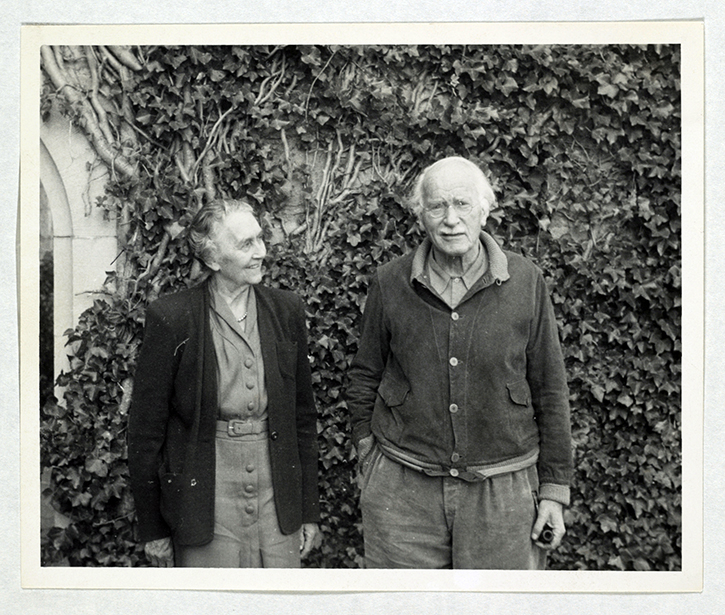 Emma Jung asked in this same seminar about the difference between intuition and revelation. Jung answered that intuition was usually one’s own activity but that intuition and revelation have the same depth source—a revelation has a more autonomous, insistent quality and a strong sense of authority, however—–it is imperative that one have a dialogue with it—most intuitives just egoically take on this sense of authority for themselves, but that can be dangerous—the power is only in receiving it with discernment and taking the time to have a dialogue with what was given.
Emma Jung asked in this same seminar about the difference between intuition and revelation. Jung answered that intuition was usually one’s own activity but that intuition and revelation have the same depth source—a revelation has a more autonomous, insistent quality and a strong sense of authority, however—–it is imperative that one have a dialogue with it—most intuitives just egoically take on this sense of authority for themselves, but that can be dangerous—the power is only in receiving it with discernment and taking the time to have a dialogue with what was given.
“This is a hard line to draw. Who tells you what the truth is” p.879 Science and religion do,” Jung reminds us—“And, furthermore it’s easier to believe if you happen to agree with it.” Then, he said, “The prophets discussed matters—perhaps God didn’t really know whether the thing was right or not.” p. 878
In The Red Book, his private journal written after his falling out with Freud, when he was ill and flooded with visions, shows us his journey to his personal window that became his own way of wild wisdom, as he recorded, dialogued and painted the archetypal figures he encountered in his active imaginations.
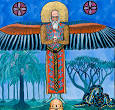 In this time of deep reflection upon his career up to that point, Jung concluded that he had been inflated with the hero archetype (a universal unconscious impulse or instinct that takes on a particular form—in this case, the impulse that all cultures feel to create a superhuman individual, a hero).
In this time of deep reflection upon his career up to that point, Jung concluded that he had been inflated with the hero archetype (a universal unconscious impulse or instinct that takes on a particular form—in this case, the impulse that all cultures feel to create a superhuman individual, a hero).
He became aware that he had been ambitious, arrogant, and successful, but at a price. Living the myth of the young hero no longer suited him, for he had given away his own individual path in the process and had lost his soul. In becoming Freud’s heir apparent (the “blond Siegfried” as the Freudians called him), he had allowed himself to be devoured by the father (in Norse myth, Siegfried’s father is named “Sigmund”) and had sacrificed his own convictions and ideas, becoming inhuman and unfeeling in the process. (I will add that Siegfried as a warrior without fear forgets his soul mate Brunhilde in his heroic journey).
Jung’s visions were telling him that his ego had been inflated with the archetype of the young hero and that this had to stop—i.e., that he must kill the young hero in himself and that this would give rise to a new myth for him to live by. Jung felt that if he hadn’t come to an understanding of these visions, he might have been tempted to act them out literally—i.e. use the revolver in the night table drawer.
One helpful author reminds us– “We have an organized center we have not yet come to know or trust” Paris, p.183
Jung was adamant about reminding people not to follow his path blindly in any way and stressed that he was only LIKE a prophet, hero or messiah, not imitating or becoming one. In other words, he asked that there be no projection on him to carry forward your work and that one must avoid an identification with the archetypal energies that arise within us, thus averting either a negative or positive inflation.
The ego is deeply challenged as the adult must let go of unnecessary identification and must learn to navigate in the world with the assistance of the positive shadow, hopefully recovered as an ally. Together they must be able to withstand the paradoxes in the positive/negative polarity of the archetypal energy without getting possessed—this translates to the ability to become a strong observer —that observer might show up in a dream as a positive shadow figure—a saving grace–it will require respect, acceptance, embrace and integration. As ego strength is stabilized and strengthened and becomes the navigator through the polarities, complexes, patterns and fields in one’s life (it can be helpful to think of the image of walking around pot holes and/or volcanoes), one has the possibility of moving forward towards personal meaning and purpose.
Jung remarked that the experience of one’s own journey is a bit like an “object thrown against” you. Think of “Paul on his way to Damascus”—-he had to be overthrown and blinded, in order to make him believe, because Paul was not convinced. p.881 Zarathustra.
As the non-ordinary way of seeing or experiencing comes in, and as one recognizes the call and learns to honor and live in two worlds, there is usually surprise and/or shock—one can feel like ”damaged goods” on one end or get caught in a positive inflation of arrogance on the other—either way the danger of identification and possession exists. The ego will also be challenged to feel out its limits, and stay in observation and dialogue to avoid this identification or possession by a complex or archetype. 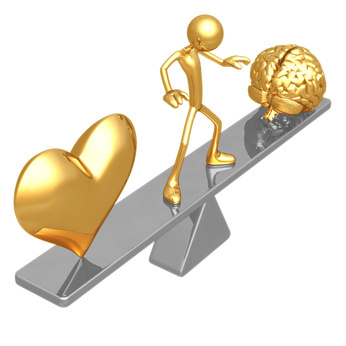
We will experience the learning of this discernment in 2 stories shortly.
Von Franz, in describing her experience of being taken over, when sensing a possession coming into her, would say —“Excuse me, I must go have it out with myself.”
Besides the value of dialoguing with archetypal figures, it is also helpful to name them, as Jung demonstrates to us in The Red Book. These abound in Myth and Fairy Tales.
Philemon came to Jung in a dream in 1913—here is how he described him—- “he was simply a superior knowledge, and he taught me psychological objectivity and the actuality of the soul. He formulated and expressed everything which I had never thought.”
Nietzsche’s inner guide and source of wild wisdom was named Zarathustra. Jung named that energy “the wisdom of nature, “”the wisdom of the underworld,” “the wisdom of the moon.” p. 874. Nietzsche ultimately became identified with Zarathustra, however, and lost differentiation.
A major understanding arises here— I will keep emphasizing that the ego must be facilitated to become strong and intact and be able to dialogue with archetypal figures, must be able to remain resilient, maintaining equilibrium within the tension that will be there between the positive and negative polarities. A sense of humor and the ability to move into investigative, respectful dialogue with the archetype is necessary to stay centered. Respect for and work with the shadow builds strength and objectivity. One also has the task of learning to recognize when overwhelm is approaching and finding correct action. (Dr. Allan Anderson, Professor of Spiritual Studies at San Diego State University used to say—“learn to stop at the back of a thing”—stop before you are too full or, “If a woman says Yes, then she says No, it is a No.”
Two stories came to mind, one from Nordic Mythology and the other from Jung’s writing in The Red Book about his terrifying experience while in an active imagination. He encounters the giant axe-wielding god, Izdubar, who becomes lame from science.
Both stories bring forth new understanding directly from the unconscious that can be translated and put to use in one’s personal world—the first is an image from Nordic mythology which offers healing from ill will plus assistance for further challenging encounters to come; the second is one of Jung’s active imaginations that uncovered a pathway of healing, along with how to become an ally to the lost, wounded parts of ourselves, most particularly, the Divine that is seeking life and space within us in order to come into the world—you are the vehicle for that to occur. Imagination, stories and images ease our way and serve as a bridge to new possibilities.
Skidbladnir, Freyr’s Ship of Gold, made by the dwarves at the request of Loki as a peacemaking offering to 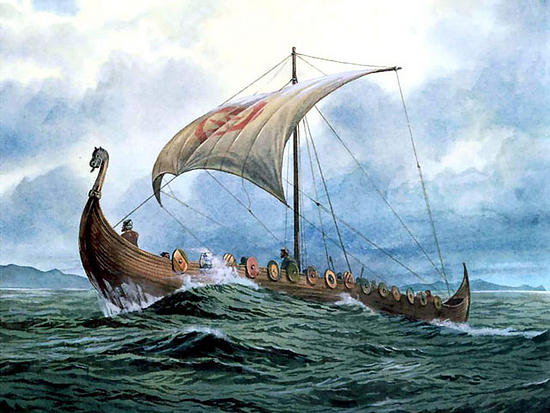 Freyr for one of his many mischiefs was an exquisitely crafted ship. It had so many parts that it could be folded up and put into one’s pocket. Not only was it available to take one wherever one needed to go, but it had the ability to carry the individual through Ragnarok (the final battle in Nordic myth). This offers a metaphor of how to escape annihilation and be able to continue moving into a new consciousness. Such does imagination allow and thus does it serve.
Freyr for one of his many mischiefs was an exquisitely crafted ship. It had so many parts that it could be folded up and put into one’s pocket. Not only was it available to take one wherever one needed to go, but it had the ability to carry the individual through Ragnarok (the final battle in Nordic myth). This offers a metaphor of how to escape annihilation and be able to continue moving into a new consciousness. Such does imagination allow and thus does it serve.
We shall see that Jung also put something in his pocket.
Here is the Active Imagination in The Red Book of coming upon the giant Izdubar—( this is an older name for the semi-divine Sumerian hero/giant Gilamesh)–and of his terrifying, moment by moment experience, his action and dialogue as he trembles with fear.
The theme of his overdeveloped intellect and the need to reclaim his lost soul are revealed in his attempts at rational explanation to Izdubar, which strike the giant like poisonous darts, laying him low. Too late in the encounter he realizes how the tyranny of reason and intellect have poisoned the visionary, the magical and the imaginative ways of thinking that the Giant knows.
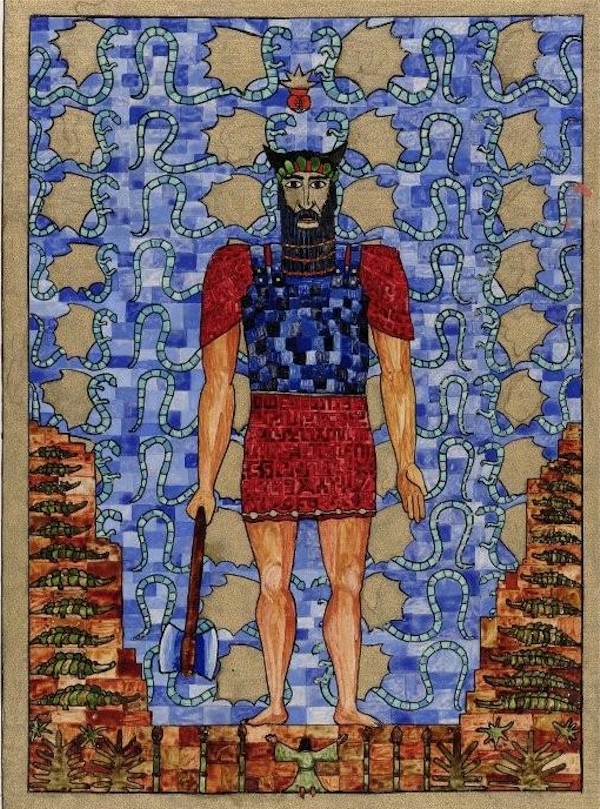
“Two bull horns rise from his great head, and a rattling suit of armor covers his chest. His black beard is ruffled and decked with exquisite stones. The giant is carrying a sparkling double-axe in his hand, used to strike bulls. Before I can recover from my amazed fright, the giant is standing before me. I look at his face: it is faint and pale and deeply wrinkled. His almond-shaped eyes look at me astonished. Horror takes hold of me: this is Izdubar, the mighty, the bull man. He stands and looks at me: his face speaks of consuming inner fear, and his hands and knees tremble. Izdubar, the powerful bull trembling? Is he frightened? I call out to him?”
Jung—“Oh, Izdubar, most powerful, spare my life and forgive me for lying like a worm in your path.”
Izdubar—“I do not want your life. Where do you come from?”
Izdubar’s “eyes flicker with fury and fear. He steps a thundering pace closer. I tremble.”
Jung tells him about scholars and proven science in the West. Izdubar “collapses and sobs like a child. I stand shaking and hardly dare stir.”
Izdubar—“Miserable worm, where did you suckle on this poison?” “—your poison—has lamed me to the marrow—–oh, if only I had crushed you
When I saw you, and never heard your words.”
In justification, Jung says—“I wanted to speak the truth.”
Izdubar answers—“You call poison truth ?——Do not our astrologers and priests tell the truth? And yet theirs does not act like poison?”
The cold night begins to come upon their dialogue.
Jung—“ I don’t doubt that your priests speak the truth. It is certainly a truth, only it runs contrary to our truth.” p. 278 Red Book
Two kinds of truth existing is eventually established.
Jung—“It seems to be so. Our truth is that which comes to us from the knowledge of outer things. The truth of your priests is that which comes to you from inner things.”
Jung gathers wood and lights a fire, reflecting—“The outer opposition is a reflection of my inner opposition”—“I remain silent and think of the antagonism in my soul.” P.279 They fall asleep very late—-In the morning, Jung acknowledges–“No dream gave me the saving word.”p.281
By now he realizes he has come to love Izdubar but has no idea how to help him. By the second evening the situation feels dire. Jung withdraws to a high rock—(one must be quite alone to let the thoughts echo.) He begins to understand that Izdubar is a fantasy, but that he would never accept that he was a fantasy.
When he approached Izdubar with this understanding, the giant is terrified and highly offended, calling it “murderous” but he eventually moved into the acceptance that he was as real as a fantasy because he knew his priests would understand that.
Nonetheless, the situation remained complex—– until Jung’s inner voice further clarified that now that Izdubar was a fantasy— he had become lighter; he realized that he could now put him on his back and take him down the mountain for healing with his friends in the Western world.
Arriving in a garden, he lays Izdubar down and goes to the door—- but the door is much too small to get Izdubar through it! Realizing that a fantasy takes no space, he squeezes Izdubar into the size of an egg and puts him in his pocket in order to be able to enter the door for the healing to begin.
Jung writes, “Thus my God found salvation. He was saved precisely by what one would actually consider fatal, namely by declaring him a figment of the imagination.”
“And hence, I experienced the miracle of my body losing its heaviness when I burdened myself with the God.” —-“if you are clever take the God with you, then you will know where he is.” P.283
Thus, Jung began to come to know the difference between god as an absolute and beyond all human experience, leaving most people cold and unaffected….. versus a knowing, a recognition that a god is a powerful impulse in one’s soul….for then I know I must concern myself with him. Jung, Psyche and Symbol, 1958
Through his feelings of remorse and compassion for Izdubar, (the God within lamed by science), Jung was forever changed.
We see a re-balance and strengthening of the ego here that is bearing the stretch between the polarities of science and mystery—- a shift actually occurs from judgment and fear to assessment and discernment, within this bearing of stretching, resting and reflecting that is able to move into reality.
Jung wrote of what he discovered about himself here.
“The thinker’s passions are bad, therefore he has no pleasure…He who prefers to think than to feel, leaves his feeling to rot in darkness. It does not grow ripe, but in moldiness produces sick tendrils that do not reach the light” (p. 262 Red Book)
T.S. Eliot describes this in his own way:
“What is hell? Hell is oneself.
Hell is alone, the other figures in it
Merely projections. There is nothing to escape from
And nothing to escape to. One is always alone.”
In Little Gidding, he wrote:
Taking any route, starting from anywhere,
At any time or at any season,
It would always be the same: you would have to put off
Sense and notion. You are not here to verify,
Instruct yourself, or inform curiosity
Or carry report. You are here to kneel.
Whatever our major organ of perception, our main type is usually being one of four…thinking, feeling, intuitive or sensation– (there has been expansion of this system to include the centrovert). Responsible discernment is enhanced with this self-knowledge—real qualms will come up and, sometimes, illness through this growth process of learning in order to begin to respect one’s individual ways of perceiving.
The discovery of your typology through the Myers Briggs Typology test is available on-line. It is invaluable and offers a most helpful way to discover one’s conscious and unconscious ways of perceiving. This self-knowledge will assist personal processing.
For example, I was not convinced at all about doing this seminar. I checked in with myself and got the sense that it would not be wise for me to argue or fool around with this message, despite how put upon I felt to be told to do the seminar.
When I heard the “voice,” (no image), saying— “We are going to do a seminar,” I was shocked and said, “You have to be kidding.” Honestly, it felt preposterous. I was very busy with quite enough, thank you! The voice was not “where I was going,” so to speak and was how I felt, but that reminded me of one of my favorite poetry books, called Is This Where I Was Going? I began to understand and stopped arguing!
However, I could feel a seriousness about the whole thing and that I shouldn’t ignore this. The energy was very strong—there seemed to be no backing down and I felt I was up for a haunting if I didn’t deal with it –I knew that more dialogue than “You have to be kidding,” would be required. I thought I had gained respect long ago for these moments, but saw that I truly hadn’t been respectful!
Kane comments on this respect factor— He says —there is a real necessity for courtesy before information will appear—wisdom cannot be compelled—Kane 179—both worlds must be valued and sustained, neither one rules the other!
A clear response arrived with my offer of a bargain– “Well, okay, but this is the Last one, I said—I feel my limits—-after this I want to complete my other projects before departing this planet.”
One day some humor came in…I had been thinking— this feels like I have taken on the job of making liver palatable—tried to do that for the family—Roaring, I realized …oh, I get it, this seminar is about being able to become a “liver” and make it palatable!
Dialogue stayed with me as Intense interest bubbled up—pretty soon, I was exploring and weaving.
I am describing my sense of the sorting and sifting required to attend to both the inner and outer world demands that we are All called to attend to—the inner Impersonal Voice of the archetypal connection is Ignored at one’s peril, however. It is best to honor the Great Experiment that You Are.
So, Let’s focus on what is your own awareness and what is revelation?
Wild wisdom “cannot be ascribed to anyone.” Zarathustra, p.875 It is found “in the form of a feeling.” Ibid
 Wild wisdom reveals itself as revelation to you—you experience it, like “a living thing at the other end of the wire that reveals its presence to you.’ p. 876 It is not your own activity—it reveals itself to you, such as does an animal in a dream—it comes upon you when it chooses-—out of nowhere, “out of stones—” so to speak— “you are just the receiver, the object of revelation” —it is an “ autonomous psychical factor, p.877 “You cannot provoke it.” Here, in the pause such as one would have with the presence of a wild animal—- the inexpressible, the unknown that might shape into a voice, a feeling, a sensation, a knowing. Many have attempted to name or describe this receptive space through poetry, art, music, and all the creative avenues available to us. Heraclitus, the Christian Mystic named the result “elegance”-
Wild wisdom reveals itself as revelation to you—you experience it, like “a living thing at the other end of the wire that reveals its presence to you.’ p. 876 It is not your own activity—it reveals itself to you, such as does an animal in a dream—it comes upon you when it chooses-—out of nowhere, “out of stones—” so to speak— “you are just the receiver, the object of revelation” —it is an “ autonomous psychical factor, p.877 “You cannot provoke it.” Here, in the pause such as one would have with the presence of a wild animal—- the inexpressible, the unknown that might shape into a voice, a feeling, a sensation, a knowing. Many have attempted to name or describe this receptive space through poetry, art, music, and all the creative avenues available to us. Heraclitus, the Christian Mystic named the result “elegance”-
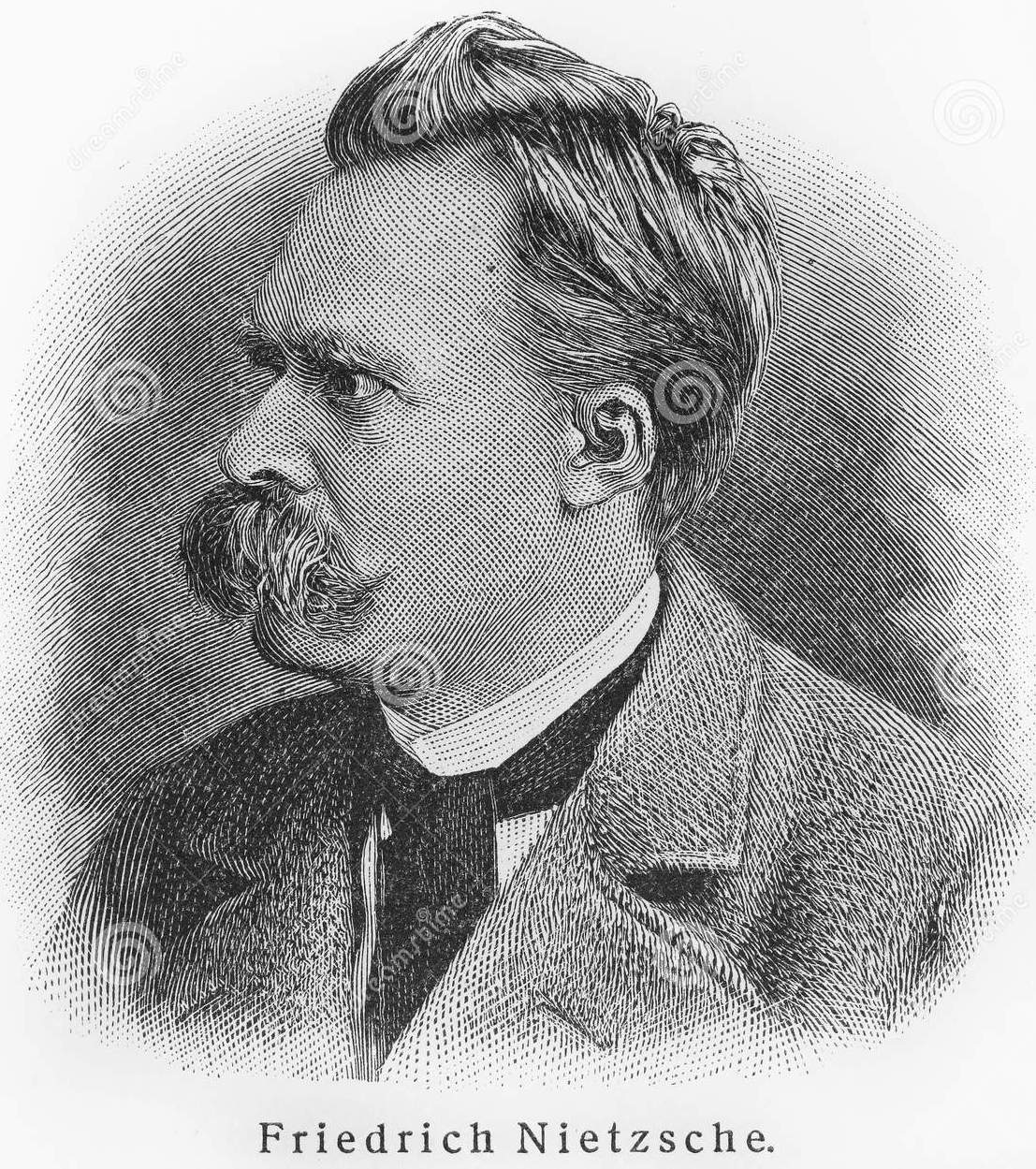 Nietzsche called it the “way of fear”–he said it would guarantee “experiencing the totality of life.” Zarathustra, p.129
Nietzsche called it the “way of fear”–he said it would guarantee “experiencing the totality of life.” Zarathustra, p.129
Take a look at his experiences with serpent, bird, eagle, lion, camel, a child and the hell-hound. Whether in dream or reality, the animal arrival is a big dream-pay attention moment. Jung, Zarathusttra, P.878
Wisdom may show up as a trickster animal—lioness, she-bear, bird—raven— Odin’s ravens, Hugin and Munnin, Mind and Memory, come to mind– snake, bee, cat, fox, etc. come in our in dreams or they may actually show up in reality with their timely message. Much to my amazement I met a large black King snake in my house one day.
One can be a raven and a human at the same time—here is the necessity of the double life, the double-mindedness that must live together in us. p. 149 Kane Both must survive and live together.
Jung—“you can meditate, or dream, or get drunk; you can be in the mountains, or the Sahara, or the woods—and find no wisdom whatever.” There is no “activity on our own part; if a wild animal crosses our path you don’t say you have an insight or intuit this animal.” Zarathustra, p.874
In our daily life we must also begin to think like an animal—like a bear in bear country—correct action is listening, not talking—here you must know nothing—only be available to the foreign languages of smell, sound wind, seasons, and wildness—Kane, p.115—then will arise the music of the pattern and all the relationships there in their many states of change. This ‘being in the forest’ calls for a shift of gear in awareness and the discipline to remember the value of relating to the unconscious directly, allowing perception with observation. That data availability has usually been cut off in us through abuse or interruption of our natural channels.
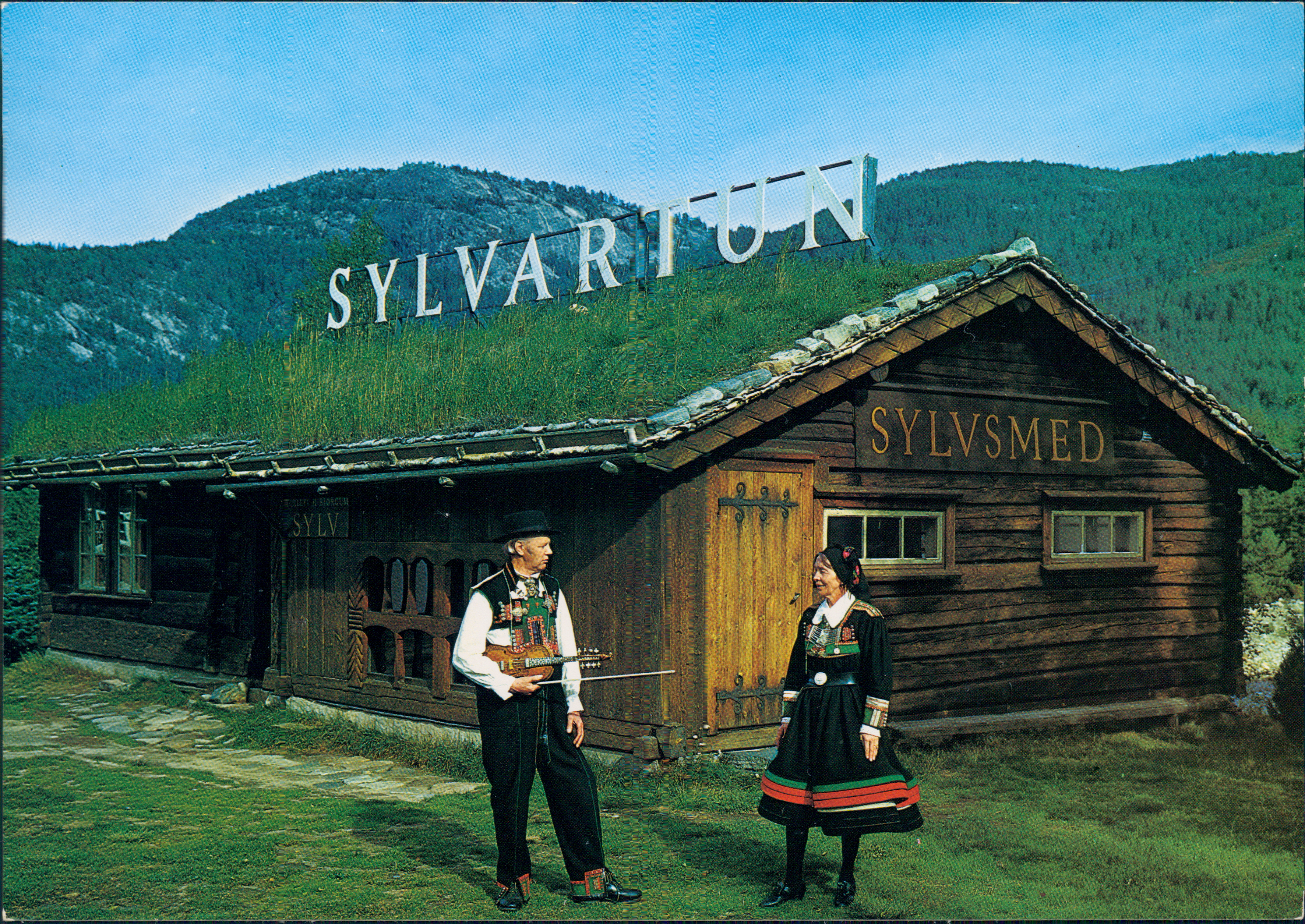 The hunter “carries the whole music of the forest in his soul.”—Kane, 115– he hears the echoes, “the signs and the songs”—he knows they are never not there—never not present and never not active. I was given such a teaching in Norway on one of many outings with my cousins. We stopped by a little private home museum in Setesdal, the home of 2 brothers—yes, already sounds like a fairytale and it felt that way—one was a violinist and artist, the other a jeweler. I felt I had entered Svartalfheim, the world of the dwarves. After buying some jewelry, the violinist asked me to sit down in the little personal museum area. As he began to play his violin, he said with a twinkle in his eyes,” Listen to the music from Underneath.” Tears rolled down my cheeks —in that moment I so deeply felt a connection to the world of the trolls and dwarves and elves and fairies that are in my heritage.
The hunter “carries the whole music of the forest in his soul.”—Kane, 115– he hears the echoes, “the signs and the songs”—he knows they are never not there—never not present and never not active. I was given such a teaching in Norway on one of many outings with my cousins. We stopped by a little private home museum in Setesdal, the home of 2 brothers—yes, already sounds like a fairytale and it felt that way—one was a violinist and artist, the other a jeweler. I felt I had entered Svartalfheim, the world of the dwarves. After buying some jewelry, the violinist asked me to sit down in the little personal museum area. As he began to play his violin, he said with a twinkle in his eyes,” Listen to the music from Underneath.” Tears rolled down my cheeks —in that moment I so deeply felt a connection to the world of the trolls and dwarves and elves and fairies that are in my heritage.
I want to share more regarding revelation from Jung’s 1930’s Zarathustra seminar. He states, “There is a living something with a will or intention that is outside, something that conveys its own self, its own command to you: it manifests itself. That is what revelation means, and that is wild wisdom.” p. 876 The experience might even be funny, maybe not necessarily even felt to be of high value, but it is just there that one must look for the meaning, for there, too, will be wisdom—
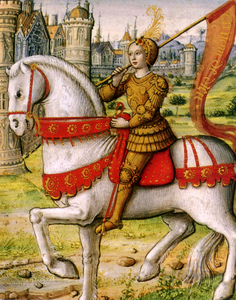 Revelations abound in history—I will only mention two—i.e. Joan of Arc’s angelic instruction at the age of 13. Her greater mission unfolded at age 17 when she was given a plan to liberate her country. She was misperceived, judged and labeled a heretic for her direct revelation. The church had been left out and took serious offense to her information. p.880 Zarathustra
Revelations abound in history—I will only mention two—i.e. Joan of Arc’s angelic instruction at the age of 13. Her greater mission unfolded at age 17 when she was given a plan to liberate her country. She was misperceived, judged and labeled a heretic for her direct revelation. The church had been left out and took serious offense to her information. p.880 Zarathustra
14th century Catholic Mystic, Julian of Norwich, very ill at age 30, wrote of her revelation experience in Revelation of Divine Love –“This shewing was quick and life like, and horrifying and dreadful, sweet and lovely.”
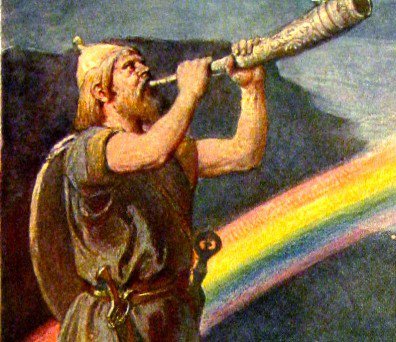 The level of listening required is described in one of the abilities of the Norse God, Heimdal, Guardian of the Rainbow Bridge who could hear the grass grow.
The level of listening required is described in one of the abilities of the Norse God, Heimdal, Guardian of the Rainbow Bridge who could hear the grass grow.
Such spontaneous religious experience brings the possibility of developing real faith—- to be able to move into the possibility of a personal relationship with Source. From that point on for the individual, there will be no more automatic dissolving into the crowd. A necessary, check in with oneself, Pause Space becomes possible and necessary, offering deep respect for self along with wider. new choices.
Before listening to a story about lost instinct, I want to address the necessity of the Recovery of instinct.
Our learning capacity mostly cuts us off from instinct and, of course, this is culturally rewarded—most of us are alienated from our instinctual foundations, i.e. our identification is usually more with conscious knowledge. It is just here that we become split through an idea of ourselves versus the real, original being that we are.
Imagination cuts through this challenge, which we will see in the story of The Snow Goose.
SOME BASICS REGARDING INSTINCT AND ARCHETYPE
Instincts—instincts form structures and patterns of human behavior while archetypes are expressed as images. Both arise and self-regulate within the collective unconscious—they pulse in our genes and psychic structure; both bring and express Life—the most important factor here is that the unconscious is Objective in the information it gives, coming through our “ contrary feelings, fantasies, emotions, impulses and dreams, none of which one makes oneself, but which come upon one objectively” Jung, The Undiscovered Self.
Archetypes with images and Instinct with patterns of behavior are inextricably linked, yet opposite—think of the flow between spirit and instinct, spirit and matter. Donleavy and Shearer describe this differentiation as the “blood soul” and the “spirit soul.”
Every instinct brings archetypal contents ( think of an animal image in dream), and will also be linked to one’s philosophy of life and will stimulate thought—there will be a sense of aliveness. Kalsched. However, Jung made it clear that if one doesn’t “think of his own free will, then you get compulsive thinking.” CW 16 Par. 185 What a task consciousness is!
“Too much of the animal distorts the civilized man, too much civilization makes sick animals.” CW 7, par. 32
It can also be helpful to think of As above, So below— ego/Self—-ego is called to mature into remembrance, relationship and communication with the Greater Self
The Instinctive factors are hunger (self-preservation), sexuality (can be diverted into other channels), the urge to activity (travel, the urge to change, play—“The creation of something new is not accomplished by the intellect but by the play instinct from inner necessity. The creative mind plays with the objects it loves.” Jung) reflection (a religious urge and search for meaning), and the creative instinct, (“mightier than its possessor,”—-it is only enhanced by the analytic process CW8, par.206
Regarding the latter, “The artist is not a person endowed with free will who seeks his own ends, but one who allows art to realize its purposes through him. As a human being he may have moods and a will and personal aims, but as an artist he is ‘man’ in a higher sense—he is ‘collective man,’ a vehicle and molder of the unconscious psychic life of mankind”. Jung, Psychology and Literature, 1930)
 Lost instincts, their return and greater purpose are hidden in this poignant story of THE SNOW GOOSE, by Paul Gallico .
Lost instincts, their return and greater purpose are hidden in this poignant story of THE SNOW GOOSE, by Paul Gallico .
The Snow Goose is set at the time of the evacuation of Dunkirk in W.W. II. It was first published in 1940 as a story in The Saturday Evening Post and became an O. Henry prizewinner in 1941. Considered a Masterpiece, it has inspired movies and musical albums. It is loosely based on the painter, Peter Scott. His first wife was the model for an illustration of Fritha. The story takes place in Rhayader , a town in Wales, meaning “waterfall.”
Phillip was an artist who was also called Rhayader. He was considered an odd man in the village, yet he had a noble bearing. He lived in the old lighthouse on the marshlands of Essex, caring for wild birds.
One day young Fritha from the village discovers an exhausted Snow Goose, wounded by gunshot on the beach and many miles away from its home.
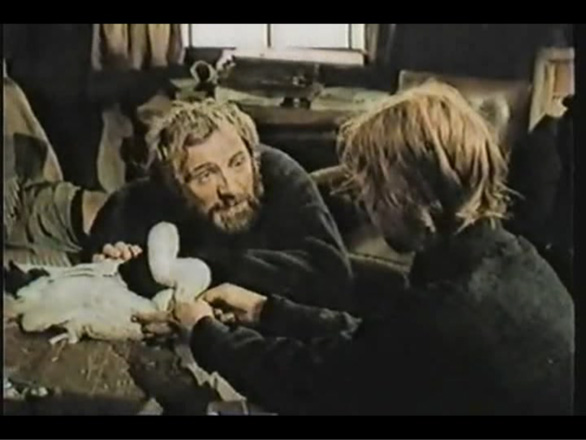 She knows of Rhayader and his work with birds and decides to seek him out, feeling her deep sadness for the Snow Goose –- caring eventually overcomes her fear of Rhayader.
She knows of Rhayader and his work with birds and decides to seek him out, feeling her deep sadness for the Snow Goose –- caring eventually overcomes her fear of Rhayader.
They named her Princess.
The Snow Goose mended rapidly. As Princess healed and Fritha continues to trust Rhayader, a strong bond forms between the three of them.
One June morning, her ”white body and black-tipped pinions, shining in the spring sun.” p.23 joined the call to fly with her kind.
Fritha shouts to Rhayader, “The Princess is going home. Listen! She is bidding us farewell.” P.24.
The departure of the Snow Goose ended Fritha’s visits to the old lighthouse and Rhayader returned to his loneliness. He paints a picture of Fritha bringing him the bird.
But Princess, to their surprise, re-visited the Great Marsh each season. A natural rhythm of time becomes marked by her arrival and departure. Fritha would receive Rhayader’s messages at the post, and hurry to the marsh. There was even time for a little sailing in his boat. She learned the lore of every wild bird that flew the marshes, mixed his paints and sometimes cooked for him, for she was no longer a child.
One year Princess did not return at her usual time—Rhayader was heartbroken and painted furiously all that summer. The birds’ migrations had changed because of the whine and roar of the bombers, for the world was on fire and seemed close to destruction. But in the fall, fully mature, a huge white bird, flying low, dropped from the skies. It seemed as if she would be staying of her own free will.
In that moment, “The spell the bird had girt about her was broken, and Frith was suddenly conscious of the fact that she was frightened, and the things that frightened her were in Rhayader’s eyes—the longing and the loneliness and the deep, welling, unspoken things that lay in and behind them as he turned them upon her. “ p.31
His last words were repeating themselves in her head as though he had said them again; ‘This is her home now—of her own free will.” P.31
“The delicate tendrils of her instincts reached to him and carried to her the message of the things he could not speak because of what he felt himself to be, mis-shapen and grotesque. And where his voice might have soothed her, her fright grew greater at his silence and the power of the unspoken things between them. The woman in her bade her take flight from something that she was not yet capable of understanding.” P.31-32
Fritha said: “I—I must go. Good-by. I be glad the—the Princess will stay. You’ll not be so alone now.” p. 31-32
By 3 weeks, however, Fritha returned–she had to know if the Princess had stayed. She found Phillip loading supplies into his sailboat—-there was an excitement about him.
“”Where must ye go?” Fritha asked.p.36
The British army is trapped on the sands of Dunkirk—it looks hopeless—every tug and fishing boat is headed across the Channel “to haul the men off the beaches to the transports and destroyers that could not reach the shallows,” p.36 to rescue as many men as possible.
Frith was “young, primitive, inarticulate.” And “did not understand war, or what had happened in France, or the meaning of the trapped army, but the blood within her told her that here was danger.” P.37 “You’ll not come back—why must it be…?” p.37..
He told her that the men on the beaches were like “the wounded and hunted birds we used to find and bring to the sanctuary. Over them fly the steel peregrines, hawks ad gyrfalcons, and they have no shelter from these iron birds of prey.”p.38” They need help, my dear, as our wild creatures have needed help, and that is why I must go. It is something that I can do. Yes, I can. For once—for once I can be a man and play my part,” p.38
“For the first time,”–Fritha—“saw that he was no longer ugly or mis-shapen or grotesque, but very beautiful.” P.38 In turmoil, she shouted—“I’ll come ‘ee”—p.39 But Rhayader made it very clear that—
“Your place in the boat would cause a soldier to be left behind, and another and another. I must go alone.”p.38
She knew she must accept his request to look after the birds.
“Suddenly from the darkness behind her came a rush of wings–something swept past her into the air”— the “thrust-forward head of the snow goose as she rose over the lighthouse, once, headed towards Rhayader’s sail, “slanting in the breeze.” P. 40
The story is yet told in the East Chapel pub—-“A goose, a bloomin’ goose, so ‘elp me”—It come flyin down outa the muck an’ stink an’ smoke of Dunkirk that was over’ead. It was white, wiv black on its wings, an’ it circles us like a bloomin’ dive bomber.’ P.41-42
An’ then around a bend ‘e comes in a bloody little sailboat, sailing along as cool as you please, like a bloomin’ toff out for a pleasure spin on a Sunday afternoon at ‘Enley.”p.44—-“the water was all frothin’ with shell splashes an’ bullets, but ‘e didn’t give it no mind, ‘e didn’t. ‘E didn’t ‘have no petrol to burn or explode, an’ he sailed in between the shells.” P.44
“Into the shallows ‘e come out of the black smoke of the burnin’ destroyer, —“ An’ over’head, around and around, flies the ruddy goose.”p.46 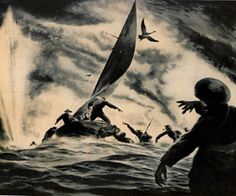
He “sings out when e’s in close—I can take seven at a time,’ P.46
“An’ the bloomin’ goose is flyin’ around and around ‘onking above the wind”—p.47
“E made trips all afternoon an’ all night, too, because the bloody light of Dunkirk burning was bright enough to see by.” p.47-48
Waves shout goodbye from the lifeboat as he sailed away, “the bird wiv ‘im.” P.48
“In an officers’ club on Brook Street, a retired naval officer,” p. 149 Keith Brill-Oudener—“ was telling of his experiences during the evaluation of Dunkirk. He said that four times his tug had brought soldiers out, but he had to retreat with a hole in her side, barely getting back to Dover. Another naval reserved officer blasted out: “Did you run across that queer sort of legend about a wild goose?”—
“If you saw it, you were eventually saved. That sort of thing.”p.50
“H’m’m’m,” said Brill-Oudener, “a wild goose. I saw a tame one. Dashed strange experience. Tragic, in a way, too.” P.51 Third trip back there was a “derelict small boat”—we changed our course to see–a body in her. And a bird perched on the rail.”p.51
Suddenly a big mine was floating by—we blew it up with rifle fire and our lives were saved, but she was gone with the hit. “The bird had got up and was circling. Three times, like a plane saluting. Dashed queer feeling. Then she flew off to the west.” P.52
Fritha knew from “the ancient powers” in her blood that he would not return.
One sunset “she heard the high-pitched, well-remembered note cried from the heavens.” P. 54….. Running to the sea wall, she knew there would be no sail. The Snow goose “skimmed low, then soared up again, flew in a wide, graceful spiral once around the old light, and then began to climb.” p.56
Wild spirit called to wild spirit and she seemed to be flying with the great bird” as she heard, “Fritha! Fritha! Fritha, my love. Good-by my love.”
It was “no longer the snow goose but the soul of Rhayader taking farewell of her before departing forever. She was no longer flying with it, but earthbound. She stretched her arms up into the sky and stood on tiptoes, reaching, and cried: Godspeed! Godspeed, Phillip! p.56. Hugging the painting, —“she wended her way homeward along the old sea wall.”p.57 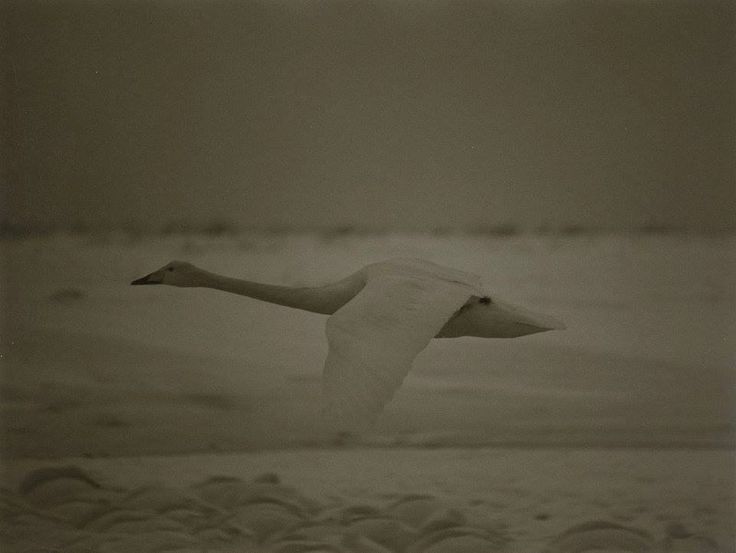
She returned for many weeks to feed the birds, but “one early morning a German pilot on a dawn raid mistook the old abandoned light for an active military objective, dived onto it, a screaming steel hawk, and blew it and all it contained into oblivion.” P.57
That evening on her visit, “the sea had moved in—Nothing was left to break the utter desolation. No marsh fowl had dared to return. Only the frightless gulls wheeled and soared and mewed their plaint over the place where it had been.” P.58.
It seems this old lighthouse has been re-built and can be visited today.
Let’s recall our original focus…..
- Being called.
- The Wounding of being called
- Discovery of and gaining respect for your process and your uniqueness.
“One must occupy oneself with oneself; otherwise one does not grow, otherwise one can never develop!” Jung, CW16, p.817
“The right way is your own way, and you should make yourself go on that way.” Jung
Individuation is the call to come to terms with one’s personal and collective unconscious. The word “Process” is the key —Process is on-going and will always be required—it never stops, whether you engage and participate in it or not. As with attending to all body functions, so will it be necessary to consciously Process spiritually and psychologically. Think of the complexities of our digestion process—-however, as Viktor Frankl wrote—here. psychologically one is nourishing Spiritual Hunger and birthing meaning and purpose.
This Process of coming into relationship to both the personal and collective unconscious in oneself requires a willingness to bear awareness of paradox, of the opposites –this facilitates a gain in ego strength.
“Individuality is so varied that in each single case the integration of the unconscious takes place in a different and unforeseen way.” “The personality becomes complete only when supplemented by the unconscious. ”The unconscious processes are compensatory, not contrary—they form a totality—–and they are always at work. Jung, CW7, p.177
“Our life Is unsure—-therefore a feeling of unsureness is much nearer to the truth than the illusion and the bluff of sureness.” If we sincerely seek wholeness, we are guaranteed to fall in just the right hole.
“Erase any longing to be normal,” Kane, p.179
The shoe that fits one person pinches another; there is no recipe for living that suits all cases. Jung
It is your totally personalized adventure.
REMEMBRANCE AND HONORING OF SOME WISDOM FOUNDATIONS:
The Book of changes, the I Ching has a Hexagram for Wisdom
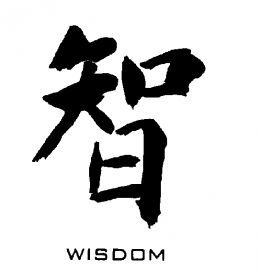
Jung’s relationship with Richard Wilhelm introduced him to the value of this 3000 year old treasure from China (Confucianism and the Taoism, of Lao-tse).
The archetype of wisdom in the I Ching is called Chun/ Difficulty at the Beginning. I will not review the meaning of the 6 line here, but the totality becomes the image of “a blade of grass pushing against an obstacle as it sprouts out of the earth.” Wilhelm says this ”indicates the way in which heaven and earth bring forth individual beings.” However, this event is “beset with difficulties. p.16 —it is the struggle of all to “attain form” within motion—perseverance, however, brings the “ prospect of great success, in spite of existing danger.” —This offers a metaphor for the repetitive dying and rebirthings in our lives, all the endings and beginnings.
Whether inner or outer, bearing this truth will demand pause and a listening from the heart to be able to take in the paradoxes and the mysteries in front of our eyes, much as one experiences during the birth of a child.
I have chosen comments from two other authors describing the Hexagram of Wisdom:
Taoist Master Alfred Huang’s book, The Complete I Ching names Hexagram #3, Zhun, Beginning.
He describes Wisdom as a “gathering,” an “ assembling and filling up” for the growth of the life force in the root. A plant must overcome the tremendous pressure of the soil. “There must be a wholehearted willingness to grow.” p. 57
This is “the truth that a newly established situation is full of the potential to develop.”p.60 — However, it comes with “irregularity and disorder.”. p.60—‘”a latent power will sprout, but in a difficult situation.” p.61 —“the superior person plans and sets things in order.” p.60—“If one plans to do something great, seeking support is a necessity.” p.62 “—make a proper choice of what to accept and what to avoid. Never act blindly.”p.63—“preserve one’s energy, waiting for the right time.” p.64 and, finally, “One must realize that when things reach an extreme they will alternate to the opposite. For this reason the I Ching always calls for restraint before going too far.” p.6 (Again, Dr. Anderson—Stop at the back of a thing)
Nobody, as long as he moves among the chaotic currents of life, is without trouble. Jung
The Image I chose to share is from Inspired Calligraphy on the net:
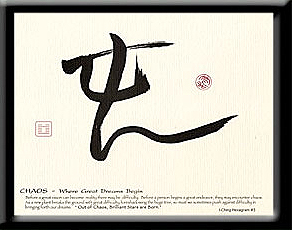 CHAOS- Where Great Dreams Begin- I-Ching Hexagram #3
CHAOS- Where Great Dreams Begin- I-Ching Hexagram #3
“Out of Chaos, Brilliant Stars are Born.”
“Before a great vision can become reality there may be difficulty. Before a person begins a great endeavor, they may encounter chaos. as a new plant breaks the ground with great difficulty, foreshadowing the huge tree, so must we sometimes push against difficulty in bringing forth our dreams”
The teachings ask that Chaos become our friend—may the human spaces of teeming complexity, confusion, complication, bursting distress and sprouting— through Hesitation and Perseverance— bring a return to the Opportunity and Potential of one’s Gifts, to Clarity, and Discernment of Self.
HERE ARE A FEW OTHER COLLECTIVE CARRIERS OF WISDOM THROUGH THE CENTURIES DESERVING HONORABLE MENTION
Most well known are—-The Book of Proverbs—(the search for happiness), The Book of Job (the difficulty of the search), Ecclasiastes (the resignation and disappointment, The Book of Ecclesiasticus ( commonly called Sirach, or the Wisdom of Sirach —-teachings from 200-175 BCE from Ben Sirach—the largest wisdom book from antiquity(a successful search) and The Wisdom of Solomon (the attainment of eternal happiness.) Schipflinger, p.3-4
The words Logos and the Holy Spirit are often used, however, the archetype of wisdom is generally personified through the Archetype of the Feminine whether in man or woman.
Probably the most well -recognized personifications of the feminine of Wisdom is Sophia.
Here is a gnostic fragment referring to Sophia from The Lost Gospel of Eve, Sophia, Goddess of Wisdom, Matthews, C.
“It is I who am you; and it is you who are me.
And wherever you are, I am there.
For I am sown in all: and you collect me from wherever you wish.
And when you collect me, it is your self that you collect.”
The Feminine Archetype is both light and dark at the same time. To develop your personal wisdom connection, there must be respect for the “archetypal aspect of the feminine as it lives in both sexes.”—296 KANE
ARCHETYPAL WISDOM AS THE CORE FEMININE
Whether we incarnated as a man or woman this lifetime, Wisdom is always referred to as the archetype of the feminine, (the milk of wisdom) —–this is the core of the woman who is supported from within through having gained a positive relationship to her inner masculine, the animus. She will be challenged to stay aware of herself in relationship for she will meet the existence of the man’s inner positive feminine, the anima —–the anima, highly developed might be a muse, goddess, inspiration, divine mother, Sophia, Virgin Mary, a nymph, Athena, maybe Neith, the Egyptian virgin mother—all cultures demonstrate this principle.
This feminine energy is primordial being, i.e.—-a generative virgin (I came into existence out of myself…” “I am everything that has been, and that is, and that shall be.”) Other examples, Net, patron of spinning, Sapientia Dei in the Wisdom of Solomon, Freyja, Goddess of Love , married to Ecstasy (Odh)—and in a letter from Jung, she is the “co-eternal, feminine nature that existed before Creation and God’s “friend and playmate from the beginning of the world.” P.33n Letters #2 She is “a spiritual whole in which all heaviness and materiality are transcended—she not only forms the earth and heaven of the retort that we call life, and the whirling wheel revolving within it, but she is also the supreme essence and distillation to which life in this world can be transformed.” P. 325 Neumann
She is as a flower, “like the scent of a blossom, her spirit always remains attached to the earthly foundation of reality.” p.325 Neumann —- her “luminous aspect” overcomes her own darkness—“the highest feminine wisdom.” P. 326 Neumann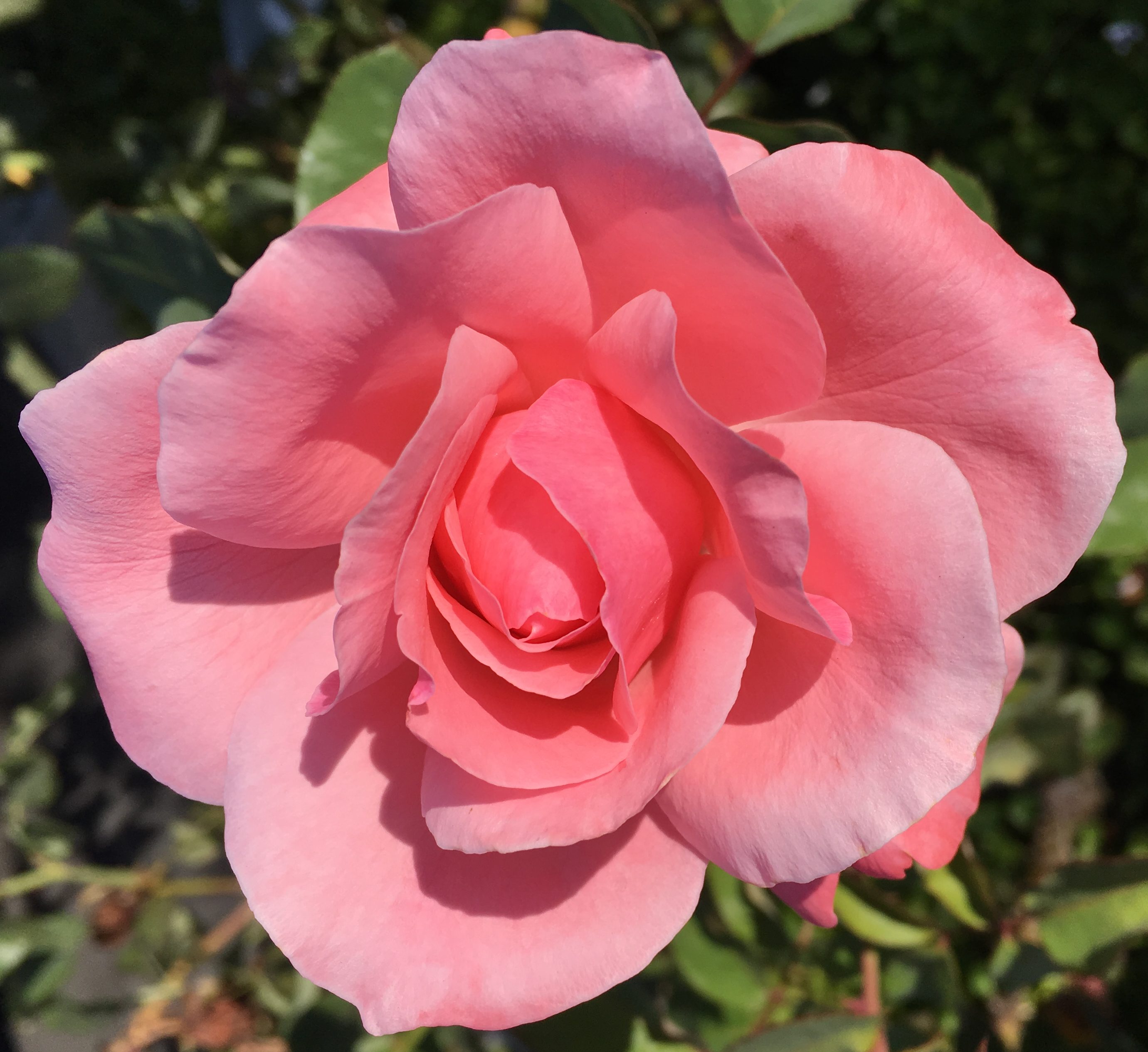
Here is a dream about the unconscious/God/an archetypal energy wanting to reach a woman demonstrating her response to the call.
“ I am on the beach, enjoying the sun. Then I am on a sailboat sailing in a small area. I see a shore in a small city where we are to dock. I could hear water spirits but I don’t want to listen. I want to get home. A giant water creature arises, a water monster that picked our boat up. I am frightened and in awe. I yelled into the spray. I don’t remember what I said. I thought we would be destroyed, but it disappeared.”
The beach or shore offers the image where consciousness ends and the unconscious begin
Does the wave come when we don’t want to listen, when we turn against the angels.
June Singer defined individuation as learning to sail guided by the wind.
One must stay oriented to the reality of these polarities within the archetype of the feminine (world, life, nature, soul—generative, nourishing protecting, warming, inspiration, including Muse and Divine Virgin versus the opposite negative pole —death, destruction, danger, distress, helplessness, terrible mother, witch) Neuman, p.81
If we get identified with either side, we are in either a positive or negative inflation—the inner and outer conflict will be there. If we want to escape this tension, we end up leaving ourselves behind.–“To live in perpetual flight from ourselves is a better thing” (i.e. it is collectively honored)- to live with ourselves demands patience, love, faith, and hope.
The conscious mind has to take this polarity into account, in order that both sides may be allowed to play their part. If the unconscious is not allowed to express itself, there are consequences. It will eventually find some way, such as illness.
The cross is an apt symbol for living and the suffering within the wholeness of life. It honors the fundamental contrariness within the whole. This metaphor honors a true understanding of spiritual resignation.
Here is one woman’s writing about this matter of choice:
“I saw a woman sleeping. In her sleep she dreamt Life stood before her, and held in each hand a gift—in the one Love, in the other freedom. And she said to the woman, ‘Choose!’ and the woman waited long; and she said, ’freedom!’ and Life said: ‘Thou hast well chosen. If thou hadst said, ‘Love,’ I would have given thee what thou didst ask for; and I would have gone from thee, and returned to thee no more. Now, the day will come when I shall return. In that day, I shall bear both gifts in one hand; I heard the woman laugh in her sleep.” Schreiner, p.35
A BRIEF LOOK AT THE ANIMA—THE DEPTH CORE OF THE FEMININE, MALE OR FEMALE
The Anima is “the chaotic urge to life” that carries “a secret knowledge or hidden wisdom–CW9 1—“the first encounter with her usually leads one to infer anything rather than wisdom.” P.31 ibid Wisdom only shows up when you come “to grips with her seriously” ibid. –it is a huge task to come to terms with any content of the collective unconscious—“only then, when this hard task has been faced, does he come to realize more and more that behind all her cruel sporting with human fate there lies something like a hidden purpose which seems to reflect a superior knowledge of life’s laws. It is just the most unexpected, the most terrifyingly chaotic things which reveal a deeper meaning. And the more this meaning is recognized, the more the anima loses her impetuous and compulsive character.
Gradually, breakwaters are built against the surging of chaos, and the meaningful divides itself from the meaningless.”. Paris p.31
“Life is crazy and meaningful all at once. Ibid
One man described his relationship with Sophia as his Anima—“She is my divine, eternal, essential self-sufficiency. She is my wheel within my wheel.” Pordage CW #16, p.297 n
—–“—the man’s opus is concerned with the erotic aspect of the anima, while the woman’s is concerned with the animus, which is a “function of the head.;” p303 CW!6
4 stages of anima evolution have been described—Eve, Helen of troy, the Virgin Mary and Sophia
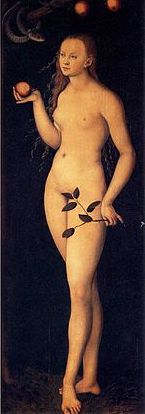 Eve—earth fertility, experienced in the personal mother—can inhibit or facilitate growth
Eve—earth fertility, experienced in the personal mother—can inhibit or facilitate growth
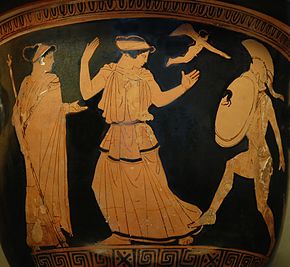 Helen of Troy—woman as collective sexual image—romantic and beginning of individualization—a seductress
Helen of Troy—woman as collective sexual image—romantic and beginning of individualization—a seductress
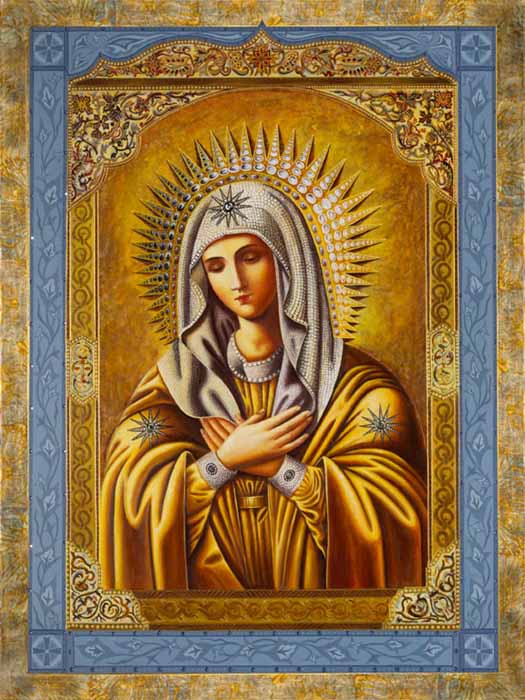
Mary—capacity for lasting relationship and spiritual connection. Erotic love becomes devotion

Sophia—wisdom, inspiration, a guide to man’s inner life and his search for meaning. She derives her wisdom from the “father” (woman’s positive connection with spiritual animus) (Wise Old Man)
Jung—the anima is always associated with the source of wisdom and enlightenment, whose symbol is the old Wise Man the archetype of spirit and meaning. Letters, p.499— the anima is the road to the archetype of life leading to awareness. Vol 1
Jung’s comment to a man–say what you have to say to the figure and listen for the response. Treat the anima as a person, as something that exists. Give her ordinary human reactions—you want to receive her secrets.
She is a total advocate.
The negative Anima, on the opposite pole can be—fickle, capricious, moody, uncontrolled, capricious, emotional and uncontrolled, (without relationship to her) man becomes remote, taken over by a bitchy mood and unavailable.
However, when the capacity for relationship and feeling is mature, the anima appears in dream and myth as a spiritual guide (Ariadne, Beatrice, the Virgin Mary). Earlier I mentioned when that capacity is undeveloped and immature, the anima appears as a femme fatale, a witch, a seductress, etc. (Lorelei, Siren, Medea, Calypso, et al.) (p. 47-50).
Recall Jung’s need to kill Sigfried—hero myths in all ancient cultures capture the tragic consequences of the young hero’s over-development of his abilities at the expense of his humanity and relationships—after they begin to accumulate heroic deeds and reputation, there is abandonment of the feminine— Jason abandons Medea, Theseus abandons Ariadne, Aeneas abandons Dido. 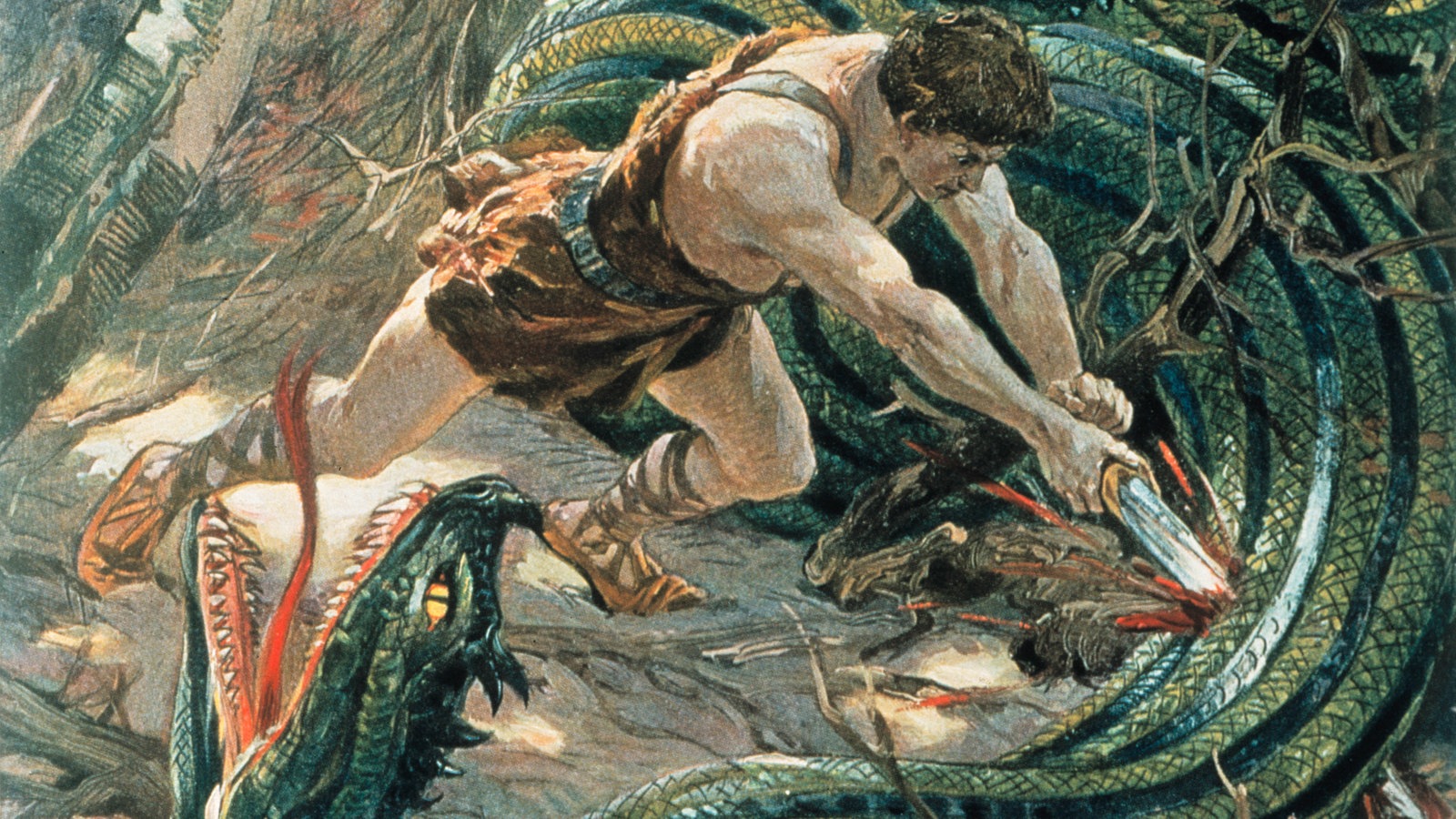 In Jung’s particular case, he had spent the first half of his life developing the functions of intuition and thinking, leaving feeling and sensation neglected and undeveloped. It is perhaps no surprise that he began having marital problems at this time and began his affair with Toni Wolff, perhaps an attempt to re-claim the soul he had lost in his heroic career thus far. Jung would theorize later on, that a primary challenge for men in the second half of life is to integrate and develop neglected aspects of the psyche, especially the anima. The main theme of The Red Book is “the Re-Finding of the Soul” or, as another title states, “Modern Man in Search of a Soul.”
In Jung’s particular case, he had spent the first half of his life developing the functions of intuition and thinking, leaving feeling and sensation neglected and undeveloped. It is perhaps no surprise that he began having marital problems at this time and began his affair with Toni Wolff, perhaps an attempt to re-claim the soul he had lost in his heroic career thus far. Jung would theorize later on, that a primary challenge for men in the second half of life is to integrate and develop neglected aspects of the psyche, especially the anima. The main theme of The Red Book is “the Re-Finding of the Soul” or, as another title states, “Modern Man in Search of a Soul.”
In his discussion of the tragic consequence of this hero inflation, he speaks of a loss of soul. The word “soul” had many meanings for Jung, but in the context of The Red Book, it seems to refer specifically to the archetype of the anima—the archetype of relationship and feeling that typically manifests in a man’s dreams, and in patriarchal culture’s myths, as a female figure (Walker, p. 47).
THE ANIMUS—REACHING TOWARDS THE WISE OLD MAN
The recognition and differentiation of the Positive and Negative Polarities arises strongly here for the woman. One must be able to question and to ask—Where am I right now—this is a major sorting job. Do I need to stop? Who is talking besides the animus with its agenda? Once there is awareness and the best choice possible is given or made, then, is your choice safe with you—can you hold it with possible new attacks from the negative side once the decision is made? ! Self-safety is only made possible when one is willing to take full responsibility for choices made, refuse any negative animus take-over, view possibilities and probable consequences and learn.
Argumentative, critical. domineering, theoretical, obstinate, dogmatic, laying down the law, harping on principles—sound familiar?–vs recognition of an energy that actually feels like an ally, recognizes aliveness and life, a generative energy that brings inspiration, enthusiasm, support, a deeper spiritual assessment and that supports discernment and responsible, individual choice. One will eventually see a furthering flowering of one’s personal spiritual path. Take a breath on that one!!
How do we titrate nourishment and take the jump into trusting direct knowing after years of malnourishment in this regard? It will require sorting, discernment and the bearing of paradox and new sensing, new recognition of what your personal nourishment actually is versus what might have been tolerated as nourishment prior to this recognition and assessment.
Here is a woman’s dream about that jump into individuation:
“I am with a group of people who are going to go sailing. In order to get to the sailboat, we have to jump off the big cliff. I feel very reluctant to take this jump. I meet the people who are going and they are angry with me because I’m late. I have been dragging my feet about going. We go to eat at a little place near the cliff before preparing to jump. It’s pretty expensive and I realize I haven’t brought enough money for the situation. I realize that I do have enough for a medium size smoothie, but when I step forward for my order, I find myself asking for $1.30 instead of a smoothie. The man is puzzled and says, “You want cash?”
Briefly we could say that there are parts of her within the collective aspect that are ready to take the jump into seriousness and commitment to that sailboat—that process of individuation.
The dream-ego expresses reluctance
The group is angry at her reluctance, i. e. collective aspects of herself.
The realization of the cost of this new way is that it is high and there is an awareness of the energy it will take—of the cost. Sheldon Kopp said it would cost everything.
She is not ready to move forward in her present ego state.
WHAT TO REMEMBER AND CAPACITIES TO DEVELOP
- Shock and surprise does not end on the spiral of Life, but one is called to work with the transformation required. Jung offers help here:
The Shock of disappointment can be the “mother of bitterness” or an “incentive to a differentiation of feeling” This experience can cause a burst of affect or a higher development through the adjustment of feeling.—Jung, CW14, p. 248 “This culminates in wisdom if feeling is supplemented by reflection and rational insight. “Wisdom is never violent: where wisdom reigns there is no conflict between thinking and feeling.” P. 249
- Direct knowing—or revelation– requires the seeing and bearing of paradox.
“The contradiction, the paradoxical evaluation of humanity by man himself is in truth a matter for wonder….’man is an enigma.’ “ Jung, The Undiscovered Self. Nothing new is created without the acceptance of paradox.
- Recognition of one’s distractions and the old patterns served by these defenses—the development of discernment is called for within the complexes in our energy field, take-overs that have become habitual, usually supported by the collective, psychic possessions and projections keeping us out of awareness, frozen supported by justifications
- Remember to work with Projection—requires Rigorous self-examination.
“How empty of me to be so full of you.” M. Malloy
“Everything that irritates us about others can lead us to an understanding of ourselves. Jung
Consider what may need to stay inner—it will be most of it. Include remembrance of Pause, awaiting Response for correct action versus Reactivity.
5. Developing Observation, Resilience, Regenerative ability, Flexibility and Choice— enduring the stretching and the many returns and re-sets and re-organizations in one’s life. Observing without judgment, moving to assessment of all possible consequences, immediate and long range.
“There comes a time in the spiritual journey when you start making choices from a very different place. And if a choice lines up so that it supports truth, health, happiness, wisdom and love, it’s the right choice.” ~Angeles Arrien—Dr. Michael Conforti speaks of this turn in the road as “generative choice”—that which serves Life.
- Consciousness of Polarities—this includes discernment of and feeling into generative and non-generative Tension. Is the tension bearing fruit, bringing forth solutions in the choice to be patient, is it leading to answers or is it a possession by a complex that must be recognized and named?
- Ability to work with Chaos—increase of capacity to value the mysteries of the psyche and to bear the cauldron of change without identification with the storm.
- Ability to remember and to work with the Trickster—Recognize the signs of a possession or Identification coming on—be receptive to the feedback of others to help you consider this possibility—you may not see it—they do see it. Move to inner dialogue with this energy in active imagination, maintaining observation and your stance.
- Assessment of Sacrifice—what actually Is costing you too much? What needs to be made holy? Can you sacrifice naivete for the vulnerability of innocence. Consider the Reality factors in the situation—William Glasser wrote of Positive Addiction—can you accept necessary Limitation—all choices have limitation.
- Acknowledgement of the Truth of being called to be a Pioneer in yourself and the collective. As one meets personal monsters and patterns, one is actually a pioneer. Meet what destroys you and others. Monsters want recognition and a way to participate—you are the only one who can offer that avenue.
- Ability to respect and relate to the isolation factor that will be felt on this individual personal journey by gaining an archetypal perspective of your personal story.
- Become conscious of what you are feeding, what you want to feed or not!
- Remembrance of Soul Discipline as differing from necessary early discipline from family and school for collective life, which may or not have been suitable. Begin this new discipline honoring the soul in order to create a destiny out of your fate, out of what happened to you. This will take the development of a new, respectful attitude towards the soul, authentically listening to and honoring its needs. This is accomplished through the disciplines of dream recording, body movement, sketching, drawing, writing for example, all of which honor unconscious truth.
- Lean into knowing and increasing trust of your own system. Stop being afraid of yourself. Think of a bridge—“no part of the system is in a position to control the rest of the system—actually I think we would all could agree that the system is, ideally, “informational, a circuit, a loop of communication, all complementary: Kane, p.165 You have Information to see and process within yourself—discover what works and what doesn’t through your Effects
- Consideration of the Safety factor with oneself. Increase your ability to welcome home soul parts and vow to be a safe place for them on return Help them know what is true, right and lasting
Nietzsche—accept what is and the love of what is becoming.
- Consider yourself worthy of serious attention, compassion, respect and dignity. There is nothing “less than” in you—nothing!
- Pause, Listen, Sort and Sift, checking in with all 4 functions as they develop and mature—this is a life- time work. Eventually you want all 4 cylinders working as you keep on choosing to fine- tune. Maintain all aspects of your physical, psychological and spiritual vehicle. We endure to reach Ignition, Inspiration and Regeneration to be able to do what we can for Life. (Jim Silber. M.D.-personal communication)
- Coming to know your way of sharing. Jung offers a warning here—“Wisdom may be good for you but to hand it out to other people means just as much as corruption of the truth. Wisdom is the thing that one individual enjoys all by himself, and if you keep silent about it, then they will believe you, but when you talk it, you have no effect.” Jung Letters, p.201.
Here we come Full Circle from our beginning definitions of Wisdom regarding the discernment of Knowledge versus Personal Gnosis —this brings up what, when, where and how one is to share.
Jung remarked, “As far as we can discern, the sole purpose of human existence is to kindle a light in the darkness of mere being.”
- Allow expression and nurture a relationship between your modern ego and your primitive reality—Symbolism, Dreams. Jung, C.W 7, p. 97
- Ask, What does my soul want?– And –What am I leaving unattended?
Rilke’s poem, ” I Have Faith” by Rilke, ” offers great wisdom to us. Selected Poems of Rainer Maria Rilke translated by Robert Bly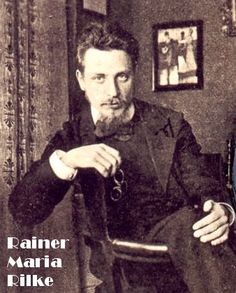
I have faith in all those things that are not yet said.
I want to set free my most holy feelings.
What no one has dared to want,
will be for me impossible to refuse.
If that is presumption, then my God, forgive me.
However, I want to tell you this one thing:
I want my best strength to be like a shoot,
with no anger and no timidity, as a shoot is;
this is the way the children love you.
With these ebbing tides, with these mouths
opening their deltas into the open sea,
with these returns, that keep growing,
I want to acknowledge you, I want to announce you,
as no one ever has before.
And if that is arrogance, then I will stay arrogant,
for the sake of my prayer,
that is so sincere and solitary
standing before your cloudy forehead.
Mark Nepo, author of Reduced to Joy, The Book of Awakening and many others that came out of his journey with cancer, calls poetry, the “unexpected utterance of the soul.”
As we say Goodbye to this special time of being together, I offer you two of my “poetic utterances” from the 90’s—-Shape Changer and Mythic Renewal
Shape Changer
What Next?
How can I embrace
The unfolding of myself to Myself?
How do I remember and honor the Mystery that I am?
A fearless, creative power explodes in me—
Dreams! Shapes! Colors! Sounds!
Demanding—trust of the Holy Self
Echoes of terror and hopelessness rush in—
Tell Me! Tell Me!
Where am I trustworthy? Where am I honest?
Where am I beautiful? Where am I powerful?
Where am I whole?
Shape Changer! Sing!
Hum into the new life!
Shape Changer! Listen!
Hear the Spirits in the winds of change
Shape Changer! Weep!
Moisten the fountains of ancient memory
Shape Changer! Dance!
Move to the rhythms of your Mythic Soul!
-Loci S. Yonder
pg.139 Ely, Howard: Editor. Best Poems of the 90’s.
National Library of Poetry, 1996. Print. Owings Mills, MD
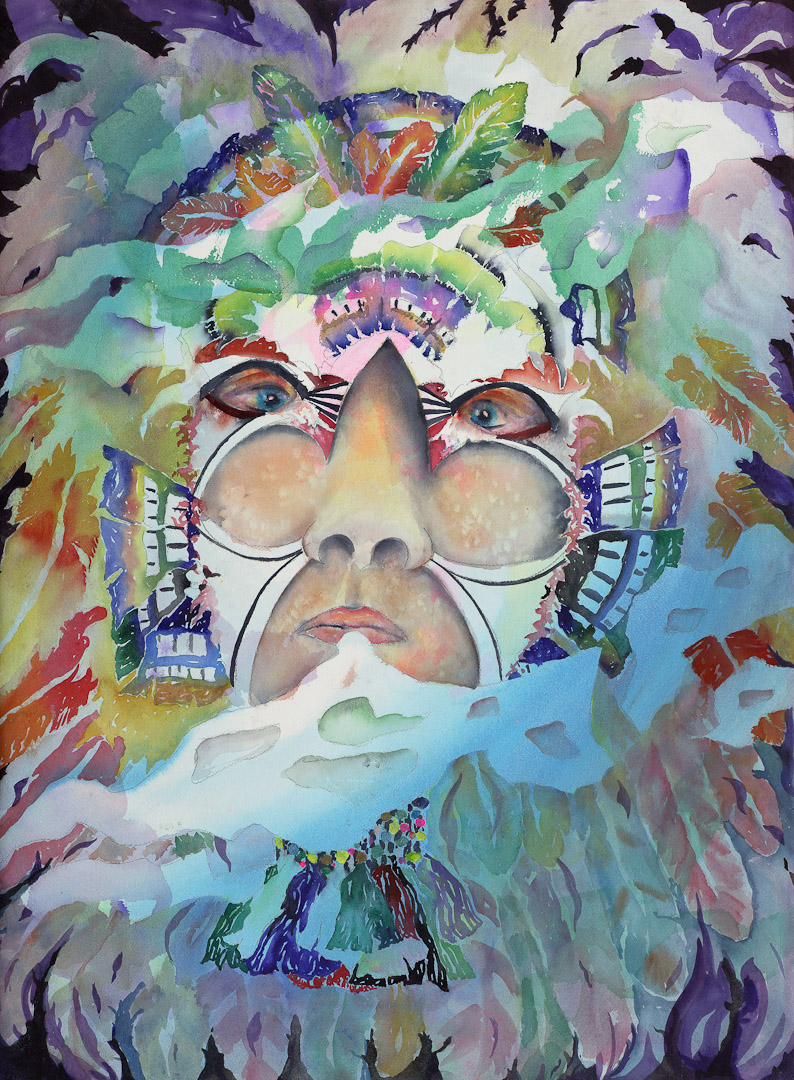
Mythic Renewal
You are the unfolding of the goddess, receive her fully!
Spark to the dance of her being,
Let body’s magical energy be heard. Reclaim! Recover! Remember!
No more Amnesia!
Be serious!
Gain your equilibrium. It is original nature.
Shape your destiny and announce who you are!
Dream and gather!
Greet the morning sun and preserve your wildness.
Trust your ability to heal and birth through your pain.
Listen to the mythic bells!
Power slumbers in no-mind and in conscious sacrifice.
Hospitality cries out anew to the hidden wounded,
Tolerated for so long!
Reclaim! Recover! Remember!
Tears and depression-willing ground for cultivation,
Offer raw power transformed
Burdens lessened, can sing!
We are each a great song!
-Loci S. Yonder
Bibliography
Cheetham, Tom. All the World an Icon: Henry Corbin and the Angelic Function of Beings. Berkeley, CA: North Atlantic, 2012. Print.
Cicchetti, Jane. Dreams, Symbols & Homeopathy: Archetypal Dimensions of Healing. Berkeley, CA: North Atlantic, 2003. Print.
Conforti, Michael. Field, Form, and Fate: Patterns in Mind, Nature, and Psyche. Woodstock, CT: Spring Publications, 1999. Print.
Corbin, Henry. The Voyage and the Messenger: Iran and Philosophy. Berkeley, CA: North Atlantic, 1998. Print.
Deardorff, Daniel. The Other Within: The Genius of Deformity in Myth, Culture & Psyche. Berkeley, CA: North Atlantic, 2009. Print.
Donleavy, Pamela & Shearer, Ann. From Ancient Myth to Modern Healing. New York: Routledge, 2008
Frankl, Viktor E., Man’s Search for Ultimate Meaning. New York: Insight, 1997. Print.
Franz, Marie-Louise Von. On Divination and Synchronicity: The Psychology of Meaningful Chance. Toronto: Inner City, 1980. Print.
Gallico, Paul. The Snow Goose. New York: A.A. Knopf, 1941. Print.
Hanson, Rick. Hardwiring Happiness: The New Brain Science of Contentment, Calm, and Confidence. N.p.: n.p., n.d. Print.
Huang, Alfred. The Complete I Ching: The Definitive Translation. Rochester, VT: Inner Traditions, 2004. Print.
Johnson, Robert A. Inner Gold: Understanding Psychological Projection. Kihei, HI: Koa, 2008. Print.
Jung, C. G. Jung Letters 1906-1950. Vol. 1. Princeton, NJ: Princeton UP, 1975. Print.
Jung, C. G. Jung Letters1951-1961. Vol. 2. Princeton, NJ: Princeton UP, 1975. Print.
Jung, C. G., Herbert Read, Michael Fordham, and Gerhard Adler. The Collected Works of C.G. Jung. New York: Pantheon, 1953. Print.
Jung, Carl Gustav, Sonu Shamdasani, Mark Kyburz, and John Peck. The Red Book. New York (N.Y.): W. W. Norton, 2009. Print.
Kalsched, Donald. Trauma and the Soul. New York: Routledge, 2013
Neumann, Erich. The Great Mother. Princeton: Princeton UP, 1963. Print.
Ni, Hua Ching. The Book of Changes and the Unchanging Truth B. Santa Monica, CA: Sevenstar Communications, 1994. Print.
Paris, Ginette. Wisdom of the Psyche: Depth Psychology after Neuroscience. London: Routledge, 2007. Print.
Parker, George. “Homes Fire.” New Yorker. N.p., 7 Apr. 2014. Web. <http://www.newyorker.com/arts/critics/books/2014/04/07/140407crbo_books_packer?currentPage=all>.
Pearsall, Paul. The Beethoven Factor: The New Positive Psychology of Hardiness, Happiness, Healing, and Hope. Charlottesville, VA: Hampton Roads Pub., 2003. Print.
Rilke, Rainer Maria, and John J. L. Mood. Rilke on Love and Other Difficulties. Translations and Considerations of Rainer Maria Rilke. New York: Norton, 1975. Print.
Schipflinger, Thomas. Sophia-Maria: A Holistic Vision of Creation. York Beach, Me.: S. Wieser, 1998. Print.
Schreiner, Olive. So Here Then Are Dreams. East Aurora, NY: Roycroft Shop, 1928. Print.
Wilhelm, Richard, and Cary F. Baynes. The I Ching; Or, Book of Changes. Princeton, NJ: Princeton UP, 1967. Print.
Wilhelm, Richard. Lectures on the I Ching: Constancy and Change. Princeton, NJ: Princeton UP, 1979. Print.
